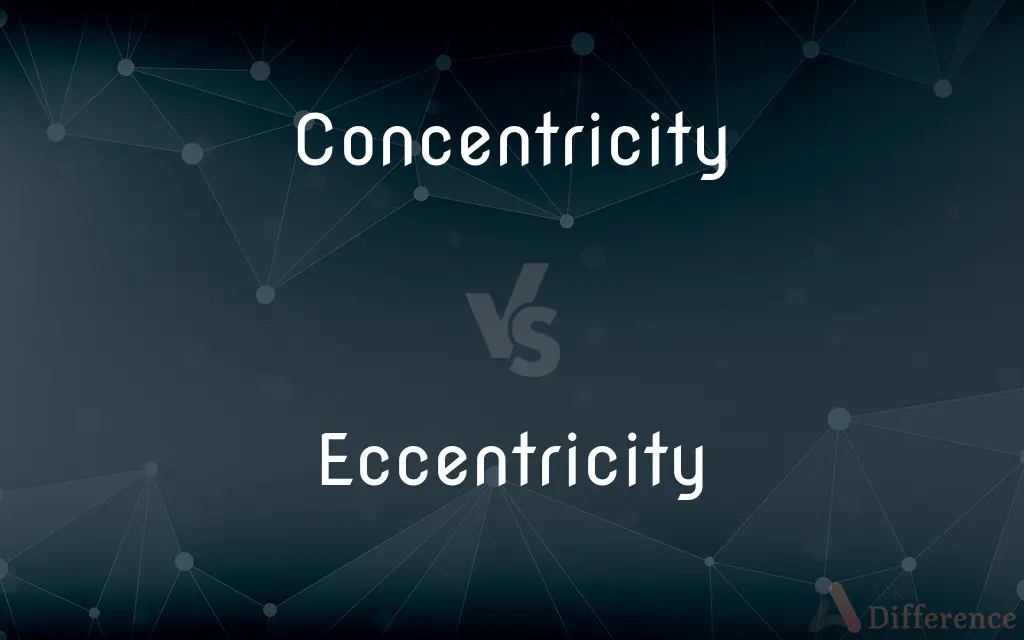Concentricity vs. Eccentricity — What's the Difference?
Edited by Tayyaba Rehman — By Maham Liaqat — Updated on March 13, 2024
Concentricity refers to the quality of sharing a common center, as seen in nested circles, while eccentricity measures the deviation of an ellipse from being circular.

Difference Between Concentricity and Eccentricity
Table of Contents
ADVERTISEMENT
Key Differences
Concentricity is a geometric term that describes the characteristic of different forms, such as circles, spheres, or arcs, sharing the same center point. For instance, the concentric circles in a target or the layers of an onion demonstrate concentricity. Eccentricity, on the other hand, quantifies how much an ellipse (including circles) deviates from being a perfect circle. It is a dimensionless parameter that ranges from 0 (for a perfect circle) to close to 1 (for a highly elongated ellipse).
This concept of concentricity is often used in engineering and design to ensure alignment and uniformity in parts and components. In astronomy, eccentricity helps describe the orbits of planets and other celestial bodies, indicating how elongated a path a planet takes around its star.
In the context of mechanical engineering and manufacturing, concentricity is a critical tolerance that ensures the uniformity of the central axis across different parts. This is crucial for parts that rotate or require precise alignment, like shafts in motors or wheels on an axle, where any deviation from concentricity can cause imbalance or wear. Eccentricity plays a significant role in characterizing the shapes and orbits in both astronomy and mathematics. For example, the eccentricity of Earth's orbit affects the variation in distance from the Sun, influencing seasonal changes. Similarly, in geometry, the eccentricity of an ellipse defines its shape, distinguishing it from circles and more elongated forms.
While concentricity focuses on the commonality of centers and symmetry, eccentricity deals with the degree of deviation from a perfect circular form. The former is about precision and alignment, whereas the latter is about describing and understanding variations in shape and trajectory.
Comparison Chart
Definition
The quality of sharing a common center.
The measure of deviation from a perfect circle.
ADVERTISEMENT
Relevance
Engineering, manufacturing, design.
Astronomy, geometry, mathematics.
Key Use
Ensuring alignment and uniformity in mechanical parts.
Describing the shape of ellipses and planetary orbits.
Measurement
Not quantified in the same way as eccentricity.
Quantified by a number between 0 and 1.
Examples
Concentric circles in a target, layers of an onion.
Earth's elliptical orbit, elongated paths of comets.
Compare with Definitions
Concentricity
Sharing a common center, as in concentric circles.
The dartboard's concentric circles help players aim and score.
Eccentricity
Quantifying the elongation of an ellipse's shape.
Comets often have high eccentricity, leading to elongated orbits.
Concentricity
Alignment of multiple layers or components around a central point.
The layers of an onion are a natural example of concentricity.
Eccentricity
The degree to which an orbit deviates from being circular.
The moon's low eccentricity results in a nearly circular orbit around Earth.
Concentricity
The characteristic of having a common center in geometric shapes.
The concentric rings of Saturn are visible through telescopes.
Eccentricity
A measure of deviation from circularity in ellipses.
The eccentricity of a planet's orbit determines its distance from the sun.
Concentricity
Ensuring precision in the center alignment of mechanical parts.
Concentricity in bearings is crucial for reducing wear and tear.
Eccentricity
In astronomy, it describes the shape of celestial bodies' orbits.
Mars has a higher orbital eccentricity than Earth, affecting its seasons.
Concentricity
Uniformity in the central axis across different parts.
The concentricity of the wheels ensures a smooth ride.
Eccentricity
A parameter in mathematics describing the shape of curves.
Eccentricity helps distinguish between circles, ellipses, and parabolas.
Concentricity
Having a common center.
Eccentricity
The quality of being eccentric.
Concentricity
The condition of being concentric.
Eccentricity
Deviation from the normal, expected, or established.
Concentricity
The state of being concentric.
Eccentricity
An example or instance of eccentric behavior.
Concentricity
The quality of having the same center (as circles inside one another)
Eccentricity
(Physics) The distance between the center of an eccentric and its axis.
Eccentricity
The ratio of the distance of any point on a conic section from a focus to its distance from the corresponding directrix. This ratio is constant for any particular conic section.
Eccentricity
Such a ratio used to define the shape of the orbit or path of a celestial body or satellite.
Eccentricity
The quality of being eccentric or odd; any eccentric behaviour.
Eccentricity
(mathematics) The ratio, constant for any particular conic section, of the distance of a point from the focus to its distance from the directrix.
For an ellipse, the eccentricity is the ratio of the distance from the center to a focus divided by the length of the semi-major axis.
Eccentricity
(astronomy) The eccentricity of the conic section (usually an ellipse) defined by the orbit of a given object around a reference object (such as that of a planet around the sun).
Eccentricity
The state of being eccentric; deviation from the customary line of conduct; oddity.
Eccentricity
The ratio of the distance between the center and the focus of an ellipse or hyperbola to its semi-transverse axis.
Eccentricity
The ratio of the distance of the center of the orbit of a heavenly body from the center of the body round which it revolves to the semi-transverse axis of the orbit.
Eccentricity
The distance of the center of figure of a body, as of an eccentric, from an axis about which it turns; the throw.
Eccentricity
Strange and unconventional behavior
Eccentricity
(geometry) a ratio describing the shape of a conic section; the ratio of the distance between the foci to the length of the major axis;
A circle is an ellipse with zero eccentricity
Eccentricity
A circularity that has a different center or deviates from a circular path
Common Curiosities
Can a circle have eccentricity?
Yes, a circle is a special case of an ellipse with an eccentricity of 0, indicating a perfect circle.
How does eccentricity affect an orbit?
Eccentricity affects the shape of an orbit; higher eccentricity means a more elongated orbit, which can lead to significant variations in distance from the central body during the orbit.
What is the maximum value of eccentricity for an ellipse?
The maximum eccentricity value for an ellipse approaches 1, which indicates a highly elongated shape.
How do you measure concentricity?
Concentricity is measured by comparing the centers of different shapes or components, ensuring they coincide or fall within specified tolerances.
What is concentricity in simple terms?
Concentricity refers to the condition of sharing a common center, as seen in perfectly aligned circles or spheres.
How is eccentricity used in astronomy?
In astronomy, eccentricity measures the deviation of a celestial body's orbit from a perfect circle, influencing aspects like seasonal variations and distance from the sun.
Can eccentricity be negative?
No, eccentricity ranges from 0 to nearly 1 and cannot be negative, as it represents a distance ratio.
Does concentricity apply only to circles?
While often associated with circles, concentricity can apply to any shapes or objects that share a common center, including spheres and cylindrical parts.
Why is concentricity important in manufacturing?
Concentricity is crucial in manufacturing to ensure parts fit together precisely, maintain balance in rotating components, and reduce wear and tear.
Is it possible for concentric shapes to have different sizes?
Yes, concentric shapes can vary in size but must share the same center to be considered concentric.
Share Your Discovery

Previous Comparison
Souq vs. Bazar
Next Comparison
Independence vs. IndependentAuthor Spotlight
Written by
Maham LiaqatEdited by
Tayyaba RehmanTayyaba Rehman is a distinguished writer, currently serving as a primary contributor to askdifference.com. As a researcher in semantics and etymology, Tayyaba's passion for the complexity of languages and their distinctions has found a perfect home on the platform. Tayyaba delves into the intricacies of language, distinguishing between commonly confused words and phrases, thereby providing clarity for readers worldwide.
















































